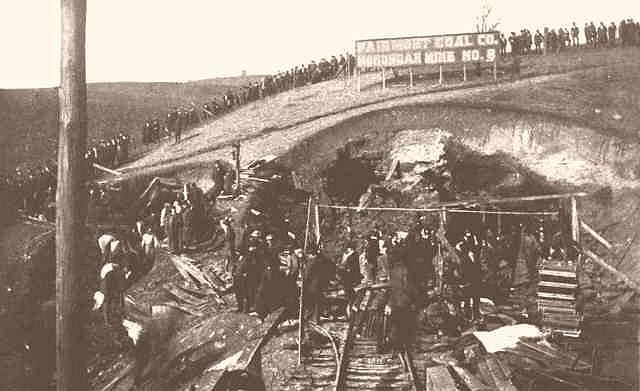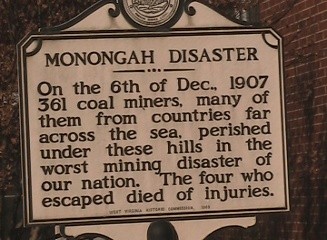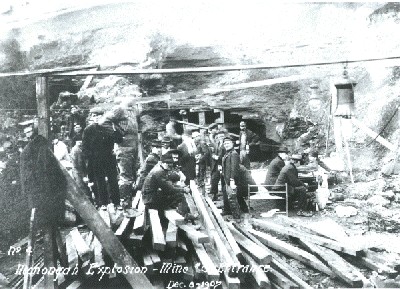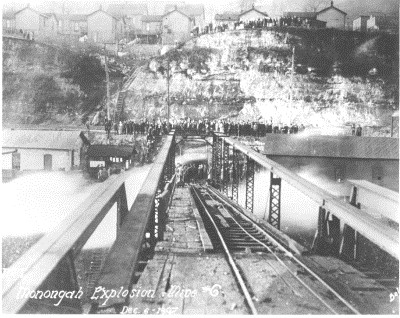Monongah Mine Disaster
Introduction
Text-to-speech Audio
Images
Outside of the mine

State historical marker for Monongah.

Survivors emerge after the explosion.

The mine after the explosion.

Backstory and Context
Text-to-speech Audio
The explosion occurred on the morning of December 6th, 1907 after a train cart exiting mine No. 6, fully loaded with almost 38 thousand lbs. of coal broke lose near the top of a trestle and slid back into the mine. As the train slid down the shaft it caused extensive damage to the electrical system and destroyed support struts and beams. The ventilation disruption and air gusts caused massive amounts of dust and gas to be mixed into the air throughout the mine. A series of massive explosion erupted within the mine, blowing as much as 100 feet of earth from around one entrance, and the sound and shockwave caused damage to the town of Monongah over half a mile away. (McAteer, 110-117)
Rescue
Workers on the surface of the mine were quickly taken to nearby towns via the still functioning cable car, and volunteer rescue workers were entering the tunnels within 20 minutes in an effort to find and free the 330+ workers trapped in the mine. Rescuers quickly worked to rebuild ventilating systems for the mine in hopes of preventing suffocation of the trapped miners. Hundreds of volunteers came in from Fairmont to help, driven by the emergence of some miners shortly after the explosion. Rescue was limited by gas and dust stirred up by the explosion (McAteer, 125-130). After over a day of searching and clearing all collapsed tunnels the only survivor that was pulled from within the mine was John Tomko, a Hungarian immigrant found with his deceased brother (McAteer, 137).
Investigation and Response
News of the explosions at the mine quickly went international due to the massive loss of life and international makeup of the workers. The immediate aftermath of the disaster saw efforts by Fairmont Coal managers and stockholders to deflect blame for the explosion, with President C.W. Watson claiming the day after the explosion that it could only have been caused by the careless use of a mining lamp (New York Times, December 8, 1907). An official report by the Bureau of Mines published after the explosion listed the official death toll at 362. Experts disagreed on the cause, citing everything from torn electrical wires to improperly used head lamps (Humphry, 28-29). The poor safety standards and the poorly planned and equipped rescue efforts at Monongah helped set the stage for the creation of the Bureau of Mines in 1910, which was established to investigate and help prevent mine explosions as well as to prepare properly trained and equipped rescue crews (Humphry, 34-35). The final death toll is still disputed mines were known to employee more workers than officially listed and often didn’t include children in employee listings.
Legacy
The makeup of the workers at Monongah resulted in swift international attention, and support came from many areas wishing to help their family in America. Many Italian workers at the mine came from Molise and nearby areas, today there are ongoing efforts to recognize the sacrifices and struggles of the immigrants at Monongah and monuments to the disaster are present in several regions of Italy today. (http://www.post-gazette.com/life/lifestyle/2007/12/05/Italians-arrive-to-honor-immigrants-killed-in-...)
